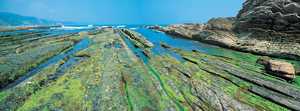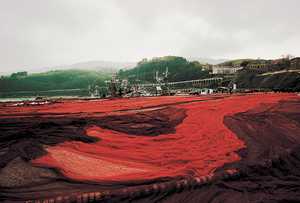gipuzkoakultura.net




Fishing played as important a part in the Roman economy as the production of cereal, wine and vegetable oil, with the population largely depending on it for their subsistence. Fresh or preserved, fish was served at practically every table in the empire; the wealthy sought out species they considered to be of high quality, but fish was also a staple diet of the poorer classes. Fish sauces were also common and are mentioned in the majority of contemporary recipes. At least four kinds of sauce are known - garum, hallec, muria y liquamen. Of these, garum was the most popular. It was obtained by allowing the entrails of the fish to ferment naturally, using salt as an antiseptic agent to prevent putrefaction. Many kinds of fish, from large species like tuna to smaller fish were used. A mixture of one part salt to eight parts fish was left to dry in the sun for several weeks and stirred daily. Finally, the paste it was strained repeatedly until a clear sauce was obtained which was then stored in amphorae for transport and sale.

To meet this demand, fish factories developed for salting fish and making fish sauces all along the Atlantic and Mediterranean coasts of Hispania, as well as the North African coast and the Atlantic coast of Gaul. Tuna was the most sought-after product, though smaller fish like sardines and mackerel were also processed. The factories were located close to the coast and a source of fresh water. They were made up of two basic spaces, one for cleaning and shredding the fish and the other containing the basins for macerating the produce with salt. For the factories to run smoothly there had to be both a supply of salt and a selective supply of fish.
The fish-processing plants on the Gipuzkoan coast shared these general features. One has been identified at Getaria, another at the Labourd port of Guethary, and it is very possible that between these two locations there were others, as yet undocumented. It seems likely that the names Getaria and Guethary are related to the Latin word cetaria, meaning a fish-processing plant. Some years ago a row of salting-basins was discovered at the railway station in Guethary and soon afterwards it was confirmed that Getaria in Gipuzkoa had also been occupied by the Romans. The first remains brought to light in 1997 was confined to the area around the parish church of San Salvador, but subsequent research has shown that Roman occupation extended throughout the old quarter of the town. The archaeological evidence has been backed by linguistic research by Joaquín Gorrochategui of the University of the Basque Country who proposes a common etymological root for Getaria and Guethary.

Rods were made of long, tough, flexible cane, and the line, of linen thread or horsehair. The hook was fixed on the end of the line, baited, and weighted with lead. Cork floats were used to signal a catch, as they are today. Deep-water fishing was also practised with a setline, with several baited hooks around a central stock. The hooks (hamus) were made of iron, bronze or copper, depending on the size of the fish to be caught. Their shape has scarcely changed over the ages, as may be seen from the collections recovered from archaeological excavations in Gipuzkoa.

Amongst the nets most commonly employed was the so-called iaculum or funda, a small, funnel-shaped net with lead weights which was cast into the water from a height; the drag-net called sagena, verriculum or tragula, and the hand-net or hypoche. All these methods are known to have been used in this area because tools have been discovered that were used for making and repairing the nets. Such is the case of the shuttle, an implement comprising a narrow rod forked at both ends which was used to gather up the nets. The shuttle was moved alternately to the left and right over the weft to braid the net. Large, long-bodied, flat-headed needles with a hole in the head have also been unearthed, which would have been used for repairing and sewing the nets. Net-weights, too, have been found, consisting of pebbles with grooves for tying string onto, whose function was to keep the net submerged.

These wicker or esparto cages were employed mainly in rivers and estuaries. They were designed in such a way that fish lured inside by the bait were unable to swim out again.
Weirs are constructions built on tidal flats and strands to trap fish at low tide. They are usually rounded in shape and make use of natural features, especially depressions. In Gipuzkoa there are a number of places where this type of fishing is practicable, as in Zumaia. In Getaria too, before extension work was completed on the harbour, it was common to see fish trapped in pools left on the uneven sea-bed at low tide.
There is also some archaeological evidence to suggest that crab nets may have been employed in this area in Roman times. A number of strips of lead have been found which are identical to those used today for weighing down the nets used for catching shellfish.